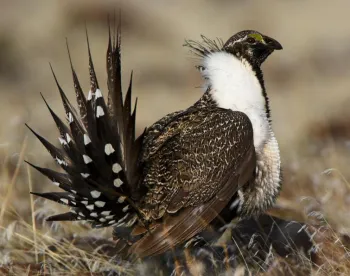It would have been hard to miss the news earlier this week that the U.S. Fish and Wildlife Service (USFWS) decided against listing the sage-grouse as threatened or endangered under the Endangered Species Act (ESA).1 As the hubbub of the announcement and the many reactions subsides, it is a good time to consider some lingering questions about the impact and import of the USFWS decision (Decision). This article addresses four of those questions.
What does the Decision mean for activities on private lands?
As a result of the Decision, sage-grouse on private land are not afforded the protections of the ESA, such as the statute’s prohibition on “take” of listed species. However, because almost all of the 11 states inhabited by the sage-grouse have a state-led sage-grouse conservation plan, it will be important for landowners and project developers to understand the scope and requirements of the applicable state plan before undertaking actions that may affect the sage-grouse. Activities on private land may still be subject to avoidance, minimization, and compensatory mitigation requirements to benefit the sage-grouse, despite the USFWS Decision. The nature and extent of those requirements will vary by state and will depend on the type of activity proposed, the potential impacts of the proposed action on the sage-grouse, and the authority underlying the state plan. In addition, projects in federal-private checkerboard areas may be subject to multiple, and potentially inconsistent, obligations for sage-grouse conservation.
Is the Service’s Decision the final word on the issue?
While the Decision fulfills the USFWS court-ordered obligation to issue a listing decision regarding the sage-grouse by September 30, 2015, it likely will not be the final word on the status of the sage-grouse for several reasons. First, some environmental interest groups have indicated their dissatisfaction with the not-warranted finding, expressing concern that the conservation efforts upon which the USFWS based its Decision—namely the sage-grouse land use plan amendments issued by the Bureau of Land Management (BLM), the U.S. Forest Service (Forest Service), and some of the state plans—are not sufficiently robust to halt the species’ decline. These dissatisfied groups may challenge the Decision. If such a challenge were successful, the USFWS would need to reconsider its Decision and could reach a different conclusion.
Second, many industry groups have indicated their intent to challenge some, if not all, of the BLM and Forest Service sage-grouse land use plan amendments, asserting that the measures in those plans are too restrictive and violate the Federal Land Policy and Management Act or other applicable laws. If those challenges are successful, and BLM and Forest Service are required to reconsider their land use plans, the USFWS would then need to evaluate whether its Decision is still valid based on any changes to the agencies’ plans, since those plans are a significant underpinning of the USFWS not-warranted finding.
Third, the efficacy of the federal agencies’ land use plans and state sage-grouse plans remains to be determined. If those plans are not implemented as originally anticipated, or if their implementation is not as effective in conserving the sage-grouse as originally anticipated, the USFWS may determine that it must revisit its Decision, or it may be petitioned to do so by an environmental group.
Fourth, some Members of Congress have indicated that they will work to enact legislation to roll back the sage-grouse protections included in the revised federal land use plans and bar the USFWS from listing the bird. The structural, temporal, and political constraints facing this Congress suggest that any such proposals are unlikely to find their way into law, but there is some small chance that Congress will figure out a way to amend the law to change various aspects of the land use plans or USFWS’ authorities under the ESA. Thus, the USFWS Decision, while an important one, is likely not the last we will hear about the legal status of the sage-grouse or its habitat.
What happens if the state plans and federal agency land use plans are implemented effectively, but other threats, like wildfire, increase?
The ESA requires the USFWS to evaluate whether listing of a species as threatened or endangered is warranted based on five factors: (1) the present or threatened destruction, modification, or curtailment of its habitat or range; (2) overutilization for commercial, recreational, scientific, or educational purposes; (3) disease or predation; (4) the inadequacy of existing regulatory mechanisms; or (5) other natural or manmade factors affecting its continued existence.2 Even if BLM, Forest Service, and state plans prove to be effective in reducing some of these threats—such as habitat destruction from infrastructure and development and other natural and manmade factors—it may not be feasible for these plans to effectively address other threats, such as wildfire and invasive species (e.g., cheatgrass). If those other threats increase in the future despite effective implementation of the sage-grouse plans, the USFWS may be compelled to revisit its Decision. The ESA requires listing of a species that qualifies as threatened or endangered, regardless of whether the listing would be able to address the underlying threats.
What are the main legal and institutional challenges to making these conservation initiatives work?
The answer to this question lies in the context of the Decision. The USFWS Decision rests on an unprecedented assemblage of commitments from federal, state, and non-government entities to manage sage-grouse habitat across a vast area of North America in new, different ways. Some of the commitments will take the form of legal requirements in state or federal natural resource management schemes. Some rely on voluntary, market-based systems of compensatory mitigation. Some are combinations of mandatory and voluntary measures. All of the new commitments rest on scientific, regulatory, and economic assumptions that are, at best, only partly proven. It is worth noting in this regard that the USFWS conspicuously did not cite certain state-sponsored conservation initiatives as bases for the Decision, suggesting that the uncertainties tied to those initiatives were so substantial that they could not be relied upon in making the listing Decision.
Perhaps the most challenging aspect of the plans on which the Decision was made is found in the various “exchanges” or similar market-based mitigation systems. These habitat credit-trading regimes represent a new realm of property law, with new markets for property rights, new managers and users of the rights, considerable uncertainty about the cultural and institutional compatibility of state wildlife management agencies and free-market entrepreneurs, all in a context where the regulatory environment is unresolved, the natural environment is changing and, in some respects, unpredictable, and the stakes are enormous. There will be years of work ahead for policymakers, scientists and, to be sure, lawyers, before this is all worked out.
1The Department of the Interior’s press release is available at https://www.doi.gov/pressreleases/historic-conservation-campaign-protects-greater-sage-grouse.
216 U.S.C. § 1533(a)(1).




 />i
/>i

